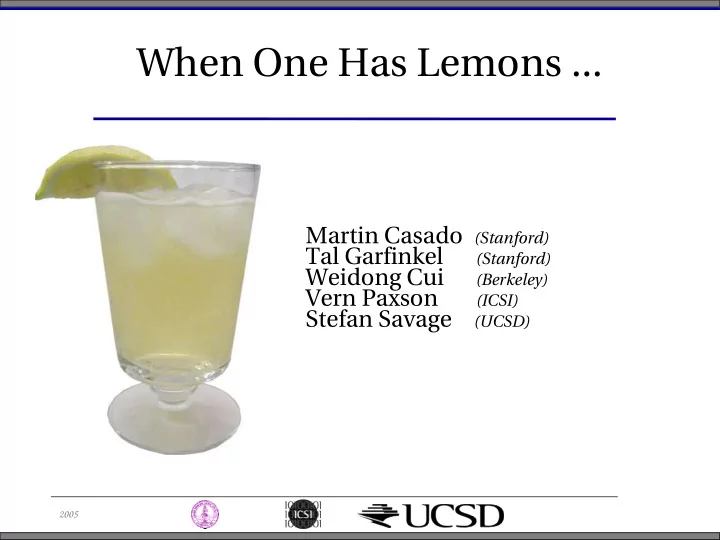

When One Has Lemons ... Martin Casado (Stanford) Tal Garfinkel (Stanford) Weidong Cui (Berkeley) Vern Paxson (ICSI) Stefan Savage (UCSD) 2005
What this Talk is About .. Spurious Traffic (generally unwanted traffic on the Internet) + Opportunistic (parasitic) Measurement (exploiting existing traffic for unrelated measurement) = Useful Internet Measurement(?) 2005
Limits Traditional Measurement Much of Internet is “hidden” from view NAT Proxies Firewalls Relatively Few Sources (planetlab has 620) Limited diversity (typically, academic networks, near the core) Limited to socially acceptable traffic patterns Privacy issues with passive measurement 2005
However ... Lots of “Unwanted”Traffic on the Internet Malware,misconfigurations, ... Many Sources 359,000 for Crv2 16,000 large automated scan Great Diversity 159 countries from 38,000 spam sources often from poorly administered machines residential bias Extreme Traffic Patterns Internet scale network events antisocial 2005
Basic Idea Opportunistic Measurement Use existing traffic for unrelated measurement purposes Collect using network telescopes Infer network properties About the sender About the Internet About the collection site ... 2005
Talk Outline Spurious Traffic Classes Example Opportunistic Measurement Studies Getting the most from your lemons Limitations Conclusions 2005
Spurious Traffic ... Generally “unwanted” Worms Spam Automated scans Misconfigurations Static settings, defaults ... 2005
Useful Traffic Generators Worms Large number of sources Code is readily available Known scanning patterns Initial outbreaks create “stress” conditions Automated Scans large number of sources can generate large, predictable bursts often generate more traffic than worms (want to find more information) 2005
Example Event Eurasian Scan From China, Japan, Germany and Korea Have identified 16,000 unique hosts Visible each day at Stanford, CAIDA, LBNL Regular, within 5 minutes LOUD and intrusive SYN packets to 9898(Dabber), 1023(Sasser), 5554(Sasser) 2005
Useful Traffic Generators Spam Source of “significant” TCP flows Many sources Often sent from compromised end-hosts (doesn't require scanning worm to have infected) Flows can be “directed” to different collection locations Network (Mis)Configurations NetGear static NTP configuration Preconfigured source address for DDoS tool 2005
Example NAT Study Using Code Red II How many sources behind NAT? Released in 2001 Infects vulnerable IIS servers Still active source of traffic HTTP connection scans Preferential scanning ½ of scans to local /8 3/8 of scans to local /16 1/8 of scans to full Internet 2005
Code Red II expect roughly 2 10 m ore 192/ 8 packets here 6 / 24s in 192/ 8 192.168/ 16 192.168.1.23 4 / 16s not shared w/ private (used as baseline) Internet Used traces from 48- hour period 487,291 scans from 1,528 one / 16 shared with 169 / 8 sources 2005
Ratio of Packets Sent to 192 2005
Ratio of Packets Sent to 169 2005
Comments on Results 65% of machines appear to be behind NAT .. however NAT reduces chance of infection IIS less likely to be behind NAT Other private prefixes (e.g. 10/8 and 172.16) CRII is old ... biased demographic 2005
Example A Heavily Spammed Domain Long online life Up to 1 million emails daily Over 40,000 source addresses Can produce “significant” tcp flows MultiQ tool from M&M tool suit (Katti, et. al 2004) 24,698 “significant” flows 2,269 sources 70% at cable speeds or below 15-20% at OC12 speeds 2005
Bottleneck Link Bandwidth From Spam Sources 2005
Getting the Most Juice out of your Lemons 2005
General Classification Pulsars Reliably send traffic over period of time Endemic worms Identified scans Super Novas Flash events Worm outbreaks DDoS attacks Large scans 2005
Other Properties Queuing delay via packet-pair variance Bottleneck link bandwidth Drop/filtering rates TTL studies (“depth of the Internet”) Super Nova can reveal capacity limits End host characteristics (e.g Witty Worm Kumar et al, 2005) Number of disks Link speeds Uptimes Infection tree Patient zero Target was military base 2005
Calibrating Collection Sites Use pulsars with known distributions ... or use movable target Determine telescope biases filtering rules drop rates rate limits 2005
Growing Lemons: Attractors and Agitators Natural Attractors (hot spots) Attract some or all of the traffic from a source Examples default configurations scanning biases based on local configuration Agitators Cause a source to send more traffic (e.g. honeynet responder) Chumming Steps to draw attackers (e.g. Irc server) 2005
Summary Traditional measurement is limited by Sources “Opacity” of the edge Ability to send disruptive traffic Spurious traffic has complimentary properties Many sources Great diversity Extreme traffic conditions 2005
However ... Noisy Lack of knowledge/control of sending environment Generally biased source sets Limited by available traffic 2005
Yet ... Preliminary studies provide promising results Can aid traditional measurement studies Much work remains to be done to develop and refine techniques 2005
Questions? 2005
Recommend
More recommend